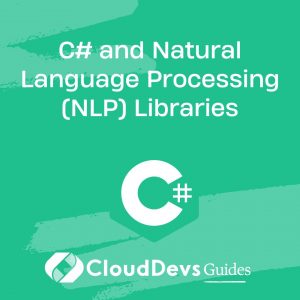C# and Natural Language Processing (NLP) Libraries
Table of Contents
Understanding Natural Language Processing (NLP)
Natural Language Processing (NLP) is a branch of artificial intelligence focused on the interaction between computers and human language. NLP involves techniques for processing and analyzing large amounts of natural language data to derive meaningful insights and perform various language-related tasks.

Using C# for NLP Tasks
C# provides a range of libraries and tools that can be used for NLP tasks. This section explores some of the key aspects and examples of how C# can be employed to perform various NLP functions.
1. Sentiment Analysis
Sentiment analysis involves determining the sentiment or emotion expressed in a piece of text. C# can be used with libraries to analyze text sentiment and gauge public opinion or feedback.
Example: Sentiment Analysis with ML.NET
Here’s an example of how to use ML.NET for sentiment analysis in C#.
```csharp
using System;
using System.Linq;
using System.Collections.Generic;
using System.IO;
using System.Threading.Tasks;
using Microsoft.ML;
using Microsoft.ML.Data;
public class SentimentData
{
[LoadColumn(0)]
public string Text { get; set; }
[LoadColumn(1)]
public bool Label { get; set; }
}
public class Prediction
{
[ColumnName("Score")]
public float Probability { get; set; }
}
class Program
{
static async Task Main()
{
var context = new MLContext();
var data = context.Data.LoadFromTextFile<SentimentData>("sentiments.csv", separatorChar: ',', hasHeader: true);
var trainTestSplit = context.Data.TrainTestSplit(data);
var model = context.Transforms.Conversion.MapValueToKey("Label")
.Append(context.Transforms.Text.FeaturizeText("Features", "Text"))
.Append(context.BinaryClassification.Trainers.SdcaLogisticRegression("Label", "Features"))
.Fit(trainTestSplit.TrainSet);
var predictions = model.Transform(trainTestSplit.TestSet);
var metrics = context.BinaryClassification.Evaluate(predictions);
Console.WriteLine($"Log-loss: {metrics.LogLoss}");
}
}
```
2. Named Entity Recognition (NER)
Named Entity Recognition involves identifying and classifying entities (e.g., names, dates, locations) in text. C# can be utilized with NLP libraries to implement NER functionalities.
Example: NER with SpaCy and Python Interoperability
While SpaCy is a popular Python library for NER, you can use it in conjunction with C# through Python interoperability.
```csharp
using System;
using Python.Runtime;
class Program
{
static void Main()
{
PythonEngine.Initialize();
using (var py = Py.GIL())
{
dynamic spacy = Py.Import("spacy");
dynamic nlp = spacy.load("en_core_web_sm");
dynamic doc = nlp("Apple is looking at buying U.K. startup for $1 billion.");
foreach (var ent in doc.ents)
{
Console.WriteLine($"Entity: {ent.text}, Label: {ent.label_}");
}
}
}
}
```
3. Text Classification
Text classification involves assigning predefined categories to text data. C# can be used with various libraries to build and apply classification models.
Example: Text Classification with Accord.NET
Accord.NET is a machine learning framework that can be used for text classification in C#.
```csharp
using System;
using System.Collections.Generic;
using Accord.MachineLearning;
using Accord.MachineLearning.VectorMachines;
using Accord.MachineLearning.VectorMachines.Learning;
using Accord.Statistics.Kernels;
using Accord.MachineLearning;
class Program
{
static void Main()
{
var texts = new[] { "I love programming", "I hate bugs", "C# is awesome", "I dislike syntax errors" };
var labels = new[] { 1, 0, 1, 0 };
// Preprocess text data
// ...
var machine = new SupportVectorMachine<Gaussian>(inputs: texts.Length, outputs: 1);
var teacher = new SequentialMinimalOptimization<Gaussian>(machine)
{
Complexity = 100 // C parameter
};
teacher.Run(texts, labels);
Console.WriteLine("Model trained.");
}
}
```
4. Language Translation
Language translation involves converting text from one language to another. C# can be used to integrate with translation APIs for this purpose.
Example: Translating Text with Google Cloud Translation API
Here’s how you might use C# to interact with the Google Cloud Translation API.
```csharp
using Google.Cloud.Translation.V2;
using System;
class Program
{
static void Main()
{
var client = TranslationClient.Create();
var response = client.TranslateText("Hello, world!", "es");
Console.WriteLine($"Translated text: {response.TranslatedText}");
}
}
```
Conclusion
C# offers a range of libraries and tools for performing various NLP tasks, from sentiment analysis and named entity recognition to text classification and language translation. By leveraging these capabilities, you can build powerful applications that understand and process human language more effectively.



